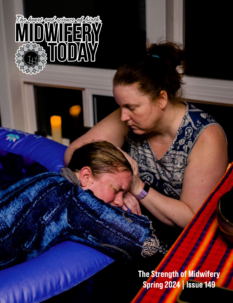
Issue 70
Summer 2004
 Theme: Hands-On Care
Theme: Hands-On Care
Dear Midwifery Today, Enclosed are photos [cover and page 37] taken by my 13-year-old daughter Lily Runyan at the birth of my fi fth child, first son, William Leopold Fern Runyan, 8 lbs 11 oz, born September 10, 2003, at 3:06 pm. I am a midwife and his mother, Diana Fern. His father is William Runyan. Also present at the birth were his other sisters Bea (age 10), Clair (15), Ava (17) and Auntie Dawn Hunter.
Thank you,
Diana Fern
Departments
- From the Editor
- Poetry
- Networking
- Tricks of the Trade
- Marion’s Message
- Question of the Quarter
- Media Reviews
- News
- Classified Advertising
- Calendar
- Photo Album
Features
- Teaching Respect for Hands-On Care—Ina May Gaskin
- The Primal Touch of Birth—Kara Maria Ananda
- Hands-On Care—Jill Cohen
- Midwives: Creators of Community—Alison Bastien
- Extra Special Care for Birthing Women who happen to be HIV-positive—Nancy Miller
AJ was the first pregnant woman to test HIV-positive at The Childbearing Center at Morris Heights in the Bronx, New York, in 1996. She was devastated to find out that she was infected with HIV. It was a privilege to care for her. And I know that our specialized care made a difference in her life and her births. - What More Can We Do About HIV?—Nancy Miller
As midwives we are ever involved in measures to prevent maternal, fetal and newborn death. In the last couple of decades, we have added measures around HIV infection in order to prevent death of women and their babies from AIDS. But are we doing enough? - Raven Lang—Dina Davidson
“I set out to be an educator but was called upon by my community to do more, and I could not say no.” Raven’s Birth Book, currently out of print, is considered a classic in North American birth literature. Numerous prominent authors cite Raven’s work and credit her as both inspirational and educational. - Traditional Midwifery—Alison Bastien
Traditional midwifery cannot be understood on a timeline or through protocols. Nor is it a fascinating compendium of “tricks.” For the same reasons that it seems a lost art, I believe it will never disappear. For wherever a woman plants her spirit and says, “I’m with you,” a tradition is carried on. - So, You Want a License, Eh?—Carol Gautschi
In joining the world of licensed midwifery, I have stepped into an environment of fear and distrust that threatens what I do and who I am. Who else will suffer before we become who we are called to be—caregivers apart from the medical hierarchy? - The Business of Midwifery—Linda Lieberman
- Library Displays Spread the Word about Midwives—Karen E. Wallace
Some men in my childbirth classes had never heard the word “midwife” prior to the first class. We can all work to make the word “midwife” more common through midwifery displays for exhibition at local libraries. I strongly believe this is an effective way to expose the general public to the Midwifery Model of Care. - Bonding—Sarojni Mehta-Lissak
- The Many Ways to Sew Up a Uterus—Judy Slome Cohain
- ICP–the Mystery Itch—Sara Rea
- A Candle—Laine Holman
- Bearer of Light–Homeopathic Phosphorus—Peggy Sawyer
International Midwife
- A Trip to the Tropics
- Cards & Letters
- Is There A Balance?—Kelly L. Holder
- Giving Birth and Being Born in Water—Albin Th öni and Ludwig Moroder
- Waterbirth—Cornelia Enning
- Hands of life—Jennifer Hall
- Preserving Traditional Midwifery Around the World—Maria Fannin
- Interviews with Maiden Midwives—Mary Kroeger
- The Cord and the Strength of Life—Marina Alzugaray
- El Cordón y la fuerza de la vida—Algo Extraordinario—Marina Alzugaray
- Mercy In Action—Vicki Penwell
= Membership Article
















